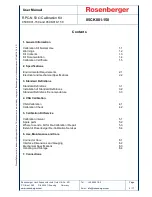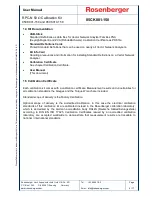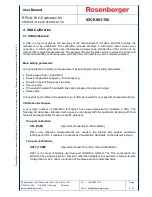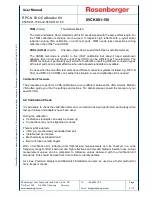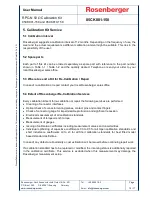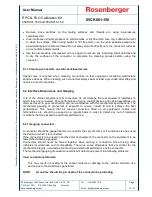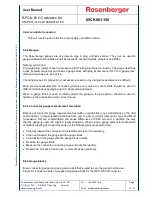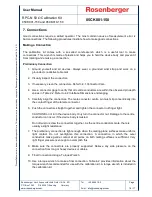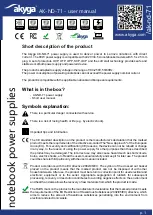
User Manual
RPC-N 50
Calibration Kit
05CK001-150 and 05CK010-150
05CK001-150
Rosenberger Hochfrequenztechnik GmbH & Co. KG
P.O.Box 1260 D-84526 Tittmoning Germany
www.rosenberger.com
Tel. : +49 8684 18-0
Email : [email protected]
Page
16 / 17
D
ie
se
s
D
ok
um
e
nt
is
t
u
rh
eb
e
rr
ec
h
tli
ch
g
es
ch
üt
zt
●
T
hi
s
d
o
cu
m
e
n
t i
s
p
ro
te
ct
ed
b
y
co
py
ri
g
ht
●
R
os
en
b
er
ge
r
H
o
ch
fr
eq
u
en
zt
ec
h
ni
k
G
m
bH
&
C
o
. K
G
7. Connections
Good connections require a skilled operator. The most common cause of measurement error is
bad connections. The following procedures illustrate how to make good connections.
Making a Connection
The calibration kit comes with a so-called combi-wrench which is a useful tool to make
connections. This wrench is made of plastic and helps you to hold the device body and prevent it
from rotating while making a connection.
Preliminary Connection
1. Ground yourself and all devices. Always wear a grounded wrist strap and work on a
grounded, conductive table mat.
2. Visually inspect the connectors.
3. If necessary, clean the connectors. Refer to 4.1 Connector Care.
4. Use a connector gage to verify that all centre conductors are within the observed pin depth
values in Table 2-2. Refer to 4.2 Interface Dimensions and Gaging.
5. Carefully align the connectors. The male connector centre pin must slip concentrically into
the contact finger of the female connector.
6. Push the connectors straight together and tighten the connector nut finger tight.
CAUTION: Do not turn the device body. Only turn the connector nut. Damage to the centre
conductor can occur if the device body is twisted.
Do not twist or screw the connectors together. As the centre conductors mate, there is
usually a slight resistance.
7. The preliminary connection is tight enough when the mating plane surfaces make uniform,
light contact. Do not overtighten this connection. A connection in which the outer
conductors make gentle contact at all points on both mating surfaces is sufficient. Very
light finger pressure is enough to accomplish this.
8. Make sure the connectors are properly supported. Relieve any side pressure on the
connection from long or heavy devices or cables.
9. Final Connection Using a Torque Wrench
10. Use a torque wrench to make a final connection. Table 4-2 provides information about the
torque wrench recommended for use with the calibration kit. A torque wrench is included in
the calibration kit.

